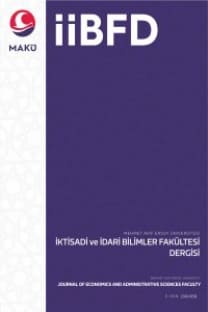SAĞLIK HİZMETLERİ TALEBİNİN NESTED MULTİNOMİNAL LOGİT MODEL İLE ANALİZİ: KAYSERİ İLİNDE BİR UYGULAMA
Sağlık, Sağlık Hizmetleri Talebi, Kesikli Tercih Modelleri, Nested Multinominal Logit Model, Kayseri, Turkey
ANALYSIS WITH NESTED MULTINOMIAL LOGIT MODEL OF DEMAND FOR HEALTHCARE: AN APPLICATION IN KAYSERI PROVINCE
Health Demand for Healthcare, Discrete Choice Models, Choice Models, Nested Multinomial Logit Model, Kayseri, Turkey,
___
- REFERENCESBörsch Supan, A. (2012), Econometric Analysis of Discrete Choice: With Applications on the Demand for Housing in the U.S. and West Germany, Springer Science & Business Media, 296.Carrasco, JA,, Ortuzar, JdD. (2002), Review and Assesment of The Nested Logit Model. Transport Reviews, 22(2), 197-218. Cisse, A. (2006), Analysis of Health Care Utilization in Cote d'Ivoire. Research Paper, Report No: 201.Feldstein, Paul J. (1966), Research On The Demand For Health Services, The Milbank Memorial Fund Quarterly, 44(3), 128-165.Fuchs, V. R. (1972), Essays In The Economics Of Health And Medicalcare, NBER Books.Grossman, M. (1972), On The Concept Of Health Capital And The Demand For Health, Journal of Political Economy, 80(2), 223-255.Guda, A. (2001), Challenges of Healthcare Financing: Economic and Welfare Effect of User Fees in Urban Ethiopia.Ethiopia: Addis Ababa University.Hensher, DA., Rose, JM., Greene, WH. (2005), Applied Choice Analysis: A Primer, Cambridge University Press.Ichoku, EH,, Leibbrandt, M.(2003), Demand for Healthcare Services in Nigeria: A Multivariate Nested Logit Model, African Development Review, 15(2-3),396-424.Jack, W. (1999), Principles Of Health Economics For Developing Countries. World Bank Publications.Kermani, MS., Ghaderi, H., Yousefi, A. (2008), Demand for Medical Care in The Urban Areas of Iran: An Empirical Investigation, Health Economics, 17(7), 849-862.Koppelman, FS., Bhat, C. (2006), A self Instructing Course in Mode Choice Modeling: Multinomial and Nested Logit Models, U.S. Department of Transportation Federal Transit Administration.Lindelow, M. (2003), Understanding Spatial Variation in The Utilization of Health Sevices: Does Quality Matter? The World Bank, Centre for Study of African Economies.Muriithi, MK. (2013), The Determinants of Health-Seeking Behavior in A Nairobi Slum: The Role of Quality and Information, European Scientific Journal, 9(8).Özkoç, H.(2013), Hastaların Sağlık Kurumu Tercihlerini Etkileyen Faktörlerin Belirlenmesi: Uygunluk Analizi ve Nested Logit Model, Dokuz Eylül Üniversitesi Sosyal Bilimler Enstitüsü Dergisi, 15(2), 267-280.Phelps, C. (1992), Health Economics. Harper Collins Publishers: New York.Qian, D., Raymond, PW., Yin, A., Nagarajan, KV., Qingyue, M.(2010), Determinants of Health Care Demand in Poor Rural China: The Case of Gansu Province, Health Policy and Planning, 24(5), 324-334.Sarma, S. K. (2003), Demand For Outpatient Health Care in Rural India: A Nested Multinomial Logit Approach. University of Manitoba.Sarma, S.(2009), Demand for Outpatient Healthcare, Applied Health Economics and Health Policy, 7(4), 265-277.Silberhorn, N., Boztuğ, Y., Hildebrandt, L.(2007), Price and Income Elasticities of Demand for Modern Health Care: The case of Infant Delivery in The Philippines, The World Bank Economic Review, 2(1), 49-76.
- ISSN: 2149-1658
- Yayın Aralığı: 4
- Yayıncı: Mehmet Akif Ersoy
SAĞLIK HİZMETLERİ TALEBİNİN NESTED MULTİNOMİNAL LOGİT MODEL İLE ANALİZİ: KAYSERİ İLİNDE BİR UYGULAMA
Zeynep ÖZTÜRK YAPRAK, Eyyup ECEVİT
Semanur SOYYİĞİT, Hüseyin TOPUZ, Halil ÖZEKİCİOĞLU
Mehmet Ali TAŞ, Hüseyin ÇİÇEK, Seher YASTIOĞLU
MUHAFAZAKÂR MUHASEBE VE YÖNETİM KURULU YAPISI İLİŞKİSİNİN İNCELENMESİ
Hüseyin TEMİZ, Merve ACAR, Elçin DALKILIÇ
FİNANSAL GELİŞME VE EKONOMİK BÜYÜME: OECD ÜLKELERİ ÖRNEĞİNDE PANEL NEDENSELLİK ANALİZİ
Seymur AĞAZADE, Aykut KARAKAYA
HASTALARIN SAĞLIK HİZMETİ KALİTESİ BEKLENTİLERİ VE ALGILAMALARI ÜZERİNE BİR ARAŞTIRMA
Gizem Zevde AYDIN, Elif DİKMETAŞ YARDAN
DOĞRUDAN YABANCI YATIRIM, BÜYÜME VE ÇEVRESEL KALİTE İLİŞKİSİ: TÜRKİYE “DİBE YARIŞAN” BİR ÜLKE Mİ?
DOĞRUDAN YABANCI YATIRIM, BÜYÜME VE ÇEVRESEL KALĠTE ĠLĠġKĠSĠ: TÜRKĠYE “DĠBE YARIġAN” BĠR ÜLKE MĠ?
